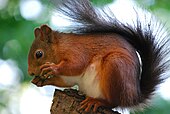| Mexican gray squirrel | |
|---|---|

| |
|
Scientific classification
| |
| Domain: | Eukaryota |
| Kingdom: | Animalia |
| Phylum: | Chordata |
| Class: | Mammalia |
| Order: | Rodentia |
| Family: | Sciuridae |
| Genus: | Sciurus |
| Species: | S. aureogaster
|
| Binomial name | |
| Sciurus aureogaster
F. Cuvier, 1829
| |
| Subspecies [2] | |
| |

| |
| Mexican gray squirrel range | |
The Mexican gray squirrel (or red-bellied squirrel) (Sciurus aureogaster) is a tree squirrel in the genus Sciurus native to Guatemala and eastern and southern Mexico. It has been introduced to the Florida Keys. [3] [1]
The alternate name should not be confused with the Indonesian red-bellied squirrel (Rubrisciurus rubriventer) or the Asian red-bellied tree squirrel (Callosciurus erythraeus).
Behaviour
Since the introduction of the species to Florida in the late 1930s, its nesting locations have become more irregular, nesting in varying species of trees and even choosing to nest in hurricane debris. [4] [5]
Ecology
Sciurus aureogaster has had an extremely negative impact on Thrinax radiata populations on Elliot Key. It uses palm fibers as nesting materials and consumes the palm itself, often killing the plant. [6]
Subspecies
The two subspecies each have many synonyms associated with them: [2]
- The subspecies S. a. aureogaster was also known as S. a. chrysogaster, S. a. ferruginiventris, S. a. hypopyrrhus, S. a. hypoxanthus, S. a. leucogaster, S. a. maurus, S. a. morio, S. a. mustelinus, S. a. raviventer and S. a. rufiventris.
- The subspecies S. a. nigrescens was also known as S. a. affinis, S. a. albipes, S. a. cervicalis, S. a. chiapensis, S. a. cocos, S. a. colimensis, S. a. effugius, S. a. frumentor, S. a. griseoflavus, S. a. hernandezi, S. a. hirtus, S. a. leucops, S. a. littoralis, S. a. nelsoni, S. a. nemoralis, S. a. perigrinator, S. a. poliopus, S. a. quercinus, S. a. rufipes, S. a. senex, S. a. socialis, S. a. tepicanus, S. a. varius and S. a. wagneri.
References
- ^ a b Koprowski, J.; Roth, L.; Reid, F.; Woodman, N.; Timm, R.; Emmons, L. (2017). "Sciurus aureogaster". IUCN Red List of Threatened Species. 2017: e.T20006A22248035. doi: 10.2305/IUCN.UK.2017-2.RLTS.T20006A22248035.en. Retrieved 12 November 2021.
- ^ a b Thorington, R.W. Jr.; Hoffmann, R.S. (2005). "Sciurus (Sciurus) aureogaster". In Wilson, D.E.; Reeder, D.M (eds.). Mammal Species of the World: a taxonomic and geographic reference (3rd ed.). The Johns Hopkins University Press. pp. 754–818. ISBN 0-8018-8221-4. OCLC 26158608.
- ^ Long, J. L. (2003). Introduced Mammals of the World: Their History, Distribution and Influence. Csiro Publishing, Collingwood, Australia. ISBN 9780643099166
- ^ Ramos-Lara, Nicolás; Cervantes, Fernando A (September 2011). "Ecology of the Mexican red-bellied squirrel (Sciurus aureogaster) in Michoacán, Mexico". The Southwestern Naturalist. 56 (3): 400–403. doi: 10.1894/N02-RTS-11.1. S2CID 85571853. Retrieved 13 November 2022.
- ^ Palmer, Geoffrey H; Koprowski, John L; Pernas, Anthony J (16 December 2013). "Nest tree and site selection of an introduced population of red-bellied squirrels (Sciurus aureogaster)". Journal of Mammalogy. 94 (6): 1274–1281. doi: 10.1644/12-MAMM-A-308.1.
- ^ Tilmant, James T. (September 1980). Investigations of Rodent Damage to the Thatch Palms Thrinax morrisii and Thrinax radiata on Elliott Key, Biscayne National Park, Florida (PDF). Everglades National Park, South Florida Research Center (Technical report). National Park Service. M-589.
External links
- Photos of Mexican Gray squirrels in Parque de Los Berros — park in Xalapa, Veracruz state, Mexico.



